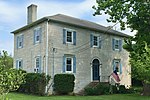Francis Hopkinson House
Bordentown, New JerseyHistoric American Buildings Survey in New JerseyHomes of United States Founding FathersHouses completed in 1750Houses in Burlington County, New Jersey ... and 4 more
Houses on the National Register of Historic Places in New JerseyNational Historic Landmarks in New JerseyNational Register of Historic Places in Burlington County, New JerseyUse mdy dates from August 2023

The Francis Hopkinson House is an historic house at 101 Farnsworth Street in Bordentown, Burlington County, New Jersey, United States. Built in 1750, it was the home of Founding Father Francis Hopkinson (1737-1791), the designer of the United States Flag and a signer of the United States Declaration of Independence. He lived in this home with his wife Ann Borden (1747-1827) from 1774 until Hopkinson's death in 1791. Ann Borden was the granddaughter of Joseph Borden, the founder of Bordentown, New Jersey. The house was designated a National Historic Landmark in 1971.
Excerpt from the Wikipedia article Francis Hopkinson House (License: CC BY-SA 3.0, Authors, Images).Francis Hopkinson House
West Park Street,
Geographical coordinates (GPS) Address Nearby Places Show on map
Geographical coordinates (GPS)
| Latitude | Longitude |
|---|---|
| N 40.148333333333 ° | E -74.713888888889 ° |
Address
West Park Street 18
08505
New Jersey, United States
Open on Google Maps






